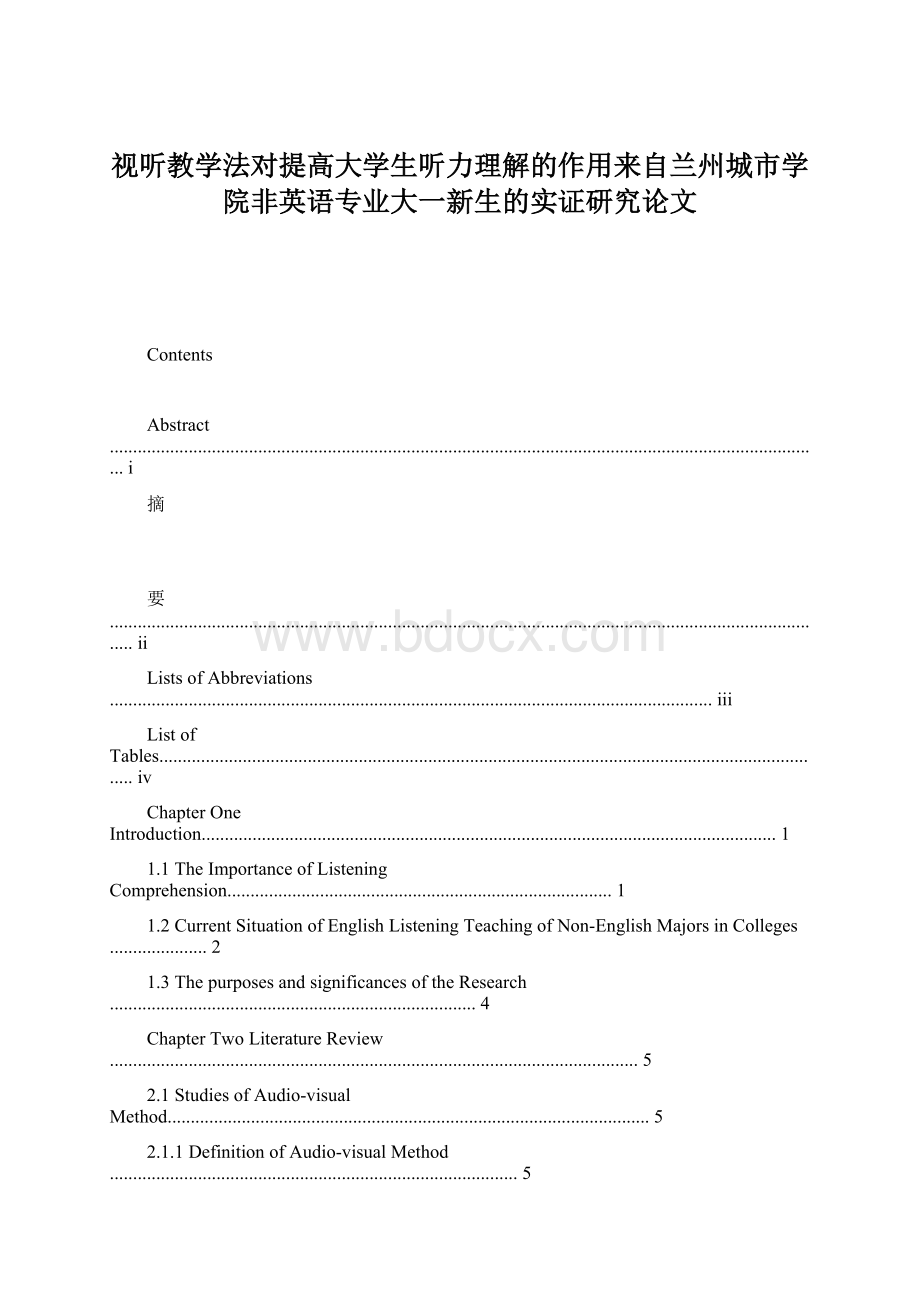视听教学法对提高大学生听力理解的作用来自兰州城市学院非英语专业大一新生的实证研究论文.docx
《视听教学法对提高大学生听力理解的作用来自兰州城市学院非英语专业大一新生的实证研究论文.docx》由会员分享,可在线阅读,更多相关《视听教学法对提高大学生听力理解的作用来自兰州城市学院非英语专业大一新生的实证研究论文.docx(113页珍藏版)》请在冰豆网上搜索。

视听教学法对提高大学生听力理解的作用来自兰州城市学院非英语专业大一新生的实证研究论文
Contents
Abstract..........................................................................................................................................................i
摘
要............................................................................................................................................................ii
ListsofAbbreviations..................................................................................................................................iii
ListofTables.................................................................................................................................................iv
ChapterOneIntroduction............................................................................................................................1
1.1TheImportanceofListeningComprehension...................................................................................1
1.2CurrentSituationofEnglishListeningTeachingofNon-EnglishMajorsinColleges.....................2
1.3ThepurposesandsignificancesoftheResearch...............................................................................4
ChapterTwoLiteratureReview..................................................................................................................5
2.1StudiesofAudio-visualMethod........................................................................................................5
2.1.1DefinitionofAudio-visualMethod........................................................................................5
2.1.2StudiesofAudio-visualMethodAbroad.................................................................................7
2.1.3StudiesofAudio-visualmethodinChina..............................................................................9
2.2StudiesofListeningComprehension...............................................................................................11
2.2.1TheDefinition........................................................................................................................11
2.2.2PreviousStudiesofListeningComprehension....................................................................12
2.2.3PreviousStudyoftheAudio-videoMaterialsandListeningComprehension.....................13
ChapterthreeTheoreticalFramework.....................................................................................................16
3.1InputTheory....................................................................................................................................16
3.2ConceptMaps.................................................................................................................................17
ChapterFourMethodology........................................................................................................................19
4.1ResearchGoal.................................................................................................................................19
4.2Questions........................................................................................................................................19
4.3Subjects............................................................................................................................................19
4.4ResearchInstruments......................................................................................................................20
4.4.1Tests.....................................................................................................................................20
4.4.2Questionnaire.......................................................................................................................20
4.5TeachingMaterials...................................................................................................................21
4.6Teaching
Procedures....................................................................................................................21
4.6.1TeachingProceduresofAudio-visualmethod......................................................................21
4.6.2TeachingproceduresintheControlClass............................................................................28
4.6DateCollectionandAnalysis..........................................................................................................31
4.7.1AnalysisofTests..................................................................................................................32
4.7.1.1TheComparisonontheResultsofPre-testforTwoClasses....................................32
4.7.1.2TheComparisonontheResultsofPost-testinTwoClasses....................................32
4.7.1.3TheComparisonontheResultsofPretestandPost-testforTwoClasses................33
4.7.1.4AnalysisofQuestionnaire.........................................................................................34
4.7.2MajorFindings.....................................................................................................................35
4.7.2.1.FindingsofListeningTests......................................................................................35
4.7.2.2FindingsofQuestionnaire.........................................................................................36
4.7.3Summary..............................................................................................................................36
ChapterFiveConclusion............................................................................................................................38
5.1Conclusion......................................................................................................................................38
5.2PedagogicalImplications................................................................................................................39
5.3Limitation........................................................................................................................................40
Reference.......................................................................................................................................................v
AppendixI..................................................................................................................................................viii
AppendixII...................................................................................................................................................ix
AppendixⅢ................................................................................................................................................xii
AppendixIV.................................................................................................................................................vi
AppendixIV..................................................................................................................................................x
AppendixVI................................................................................................................................................xii
Abstract
TrainingoflisteningisoneofthemainpurposesofcollegeEnglishteachingandisalsocrucialforthe
developmentofEnglishlanguageabilityofthestudents.Thesuccessfulinputoflisteningplaysadecisive
roleinverbalcommunicationofpeople.However,forstudentsofnon-Englishmajors,theresultofthe
listeningteachingisnotsatisfactory.
AccordingtotheworkingmemorymodelofBaddeley“aworkingmemoryincludesavisual-spatial
sketchpadfortheprocessingofvisualmaterialsandaphonologicallooppresentedinauditoryformfor
verbalmaterials”(1992:
556).Sopresentinginformationintwosensorymodalities(visualandauditory)
increasestheavailableworkingmemoryresourcesandfacilitatestheircomprehension.
Theaudio-visualmethod,byusingtheimagesandsoundstostimulateaudio-visualsensesatthesame
ornearlyatthesametime.Itusemultimediareplacesthetraditionaltape-recorder,whichcanchangethe
traditionalteachingmode,strengthentheunderstandingofthebackgroundknowledge,andbroadenthe
students'knowledgeinputchannels,soastoformtheautomatedhabitsof“stimulus-responding–
consolidating”ofthestudents.
Basedontheliteraturereview,theauthorselectedrandomlytwointactclassesfrom2012students
majoringinartfromLanzhouCityCollegetoperform10weeksteachingexperiment.Theaudio-visual
teachingmethodisusedintheExperimentalclasswhilethetraditionalteachingmethodisappliedtothe
controlclassandtwoclassesaretaughtbythesameteacher.Pre-testwasusedtoensurethattwoclassesare
comparableintheirEnglishlisteningabilityandpost-testwasusedtotestwhethertherewasadifferencein
thetwoclasses.Questionnairewasusedtoinvestigatetheattitudesofthestudentsandtheeffectofthe
teachingmethods.TheresultsareanalyzedbySPSS13.0.
Theresultindicatedthatthescoresoftheexperimentalclassaresignificantlyhigherthanthatofthe
controlclasses.Questionnairessuggestedthattheaudio-visualmethodcanfullyarousethestudents'
listeninginterestsandimprovetheirlisteningcomprehension.
Keywords:
Audio-visualMethod;ListeningComprehension;Non-EnglishMajors;CollegeStudents.
i
摘
要
听力能力的培养是英语教学的主要目的,而且对于培养学生的英语语言能力至关重要。
其输入的
成功与否对人们的口头交际起到至关重要的决定作用。
然而,对于非英语专业的学生而言,听力教学
的效果总是不尽如人意。
根据巴德利(1992:
556)的工作记忆模式,“工作记忆包括视觉空间模板和语音环路系统,其中
视觉空间模板主要